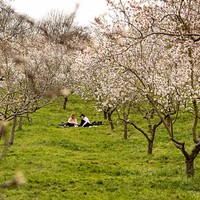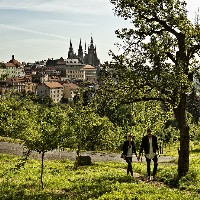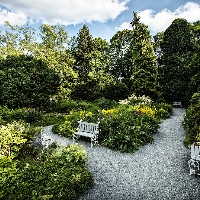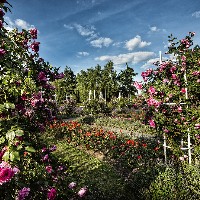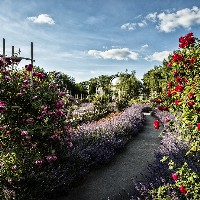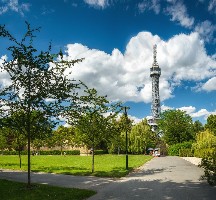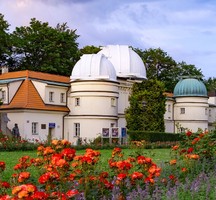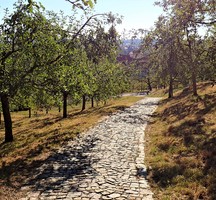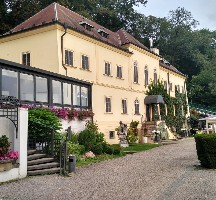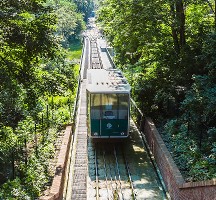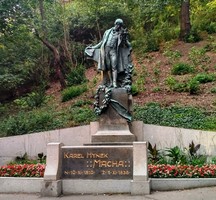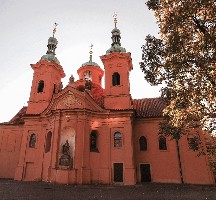Breadcrumbs navigation
Petřín Gardens (Petřínské sady)
Petřín Hill is one of the largest urban green areas and its slopes are an oasis of calm in the center of Prague. The Rose Garden, or rosarium, at the top of Petrin Hill, Nebozízek Garden and the Seminary Garden with more than 2,100 fruit trees are particularly magical. A favourite destination for families with children and couples in love. The easiest way to reach the top of the hill is with the funicular. Petrín Lookout Tower is popular for its incredible views of the city and the mirror maze is an endless source of giggles. Walking paths crisscross the park and are lined with benches with great views; there are even several playgrounds here.
- park
- views
- romance
- children‘s playground
- with children
- pets allowed
- free
Contacts
- Petřín Gardens (Petřínské sady)
- 110 00 Praha 1 – Malá Strana / Hradčany
Object history
Petřín Hill above the Vltava river between Malá Strana and Strahov is one of the most extensive green areas in the city, with the highest elevation above sea level reaching 320 - 238 m. The first written reference about it dates back to 1108, when the last members of the Vršovec family were executed in the local execution place. Back then, the hill was covered by a deep forest stretching all the way to Bílá Hora. The name Petřín was probably first used in the 17th century, and it may be derived from the Latin word petrus (the rocks). The original name was German - Laurenzberg - after the Chapel of St. Vavřinec (Laurenz), built here at the turn of the 10th century. In the Middle Ages, the forest gradually gave way to vineyards and farming lands. In the 14th century, Charles IV had a Hunger Wall built here. It is 1178 m long, 7.5 - 8 m high, and the average width is 170 cm. One explanation says he wanted to employ the starving citizens at a time when there was no crop to harvest, but the point probably was to provide Malá Strana with new fortification. Since 1980, extensive restoration of the badly damaged Hunger Wall have been realized in stages, with the aim to return it to the original state. A romantic observation place called Citadela from the last century is again used for its original purpose. Ever since long ago, there were lots of springs rising from the Petřín hills, and so an aqueduct was built here in the past. It was a system of tunnels bringing water to the Strahov monastery, to Pohořelec, and to Malá Strana, too. The tunnels went through several reconstructions. In 1965, water which kept undermining Petřín actually caused a landslip damaging the cableway track and causing other damages. After a reconstruction and completion, there are seventeen tunnels now leading the Petřín springs down to Vltava.
Over the course of centuries, Petřín hill was divided into several gardens, the cultivation of which mostly dates back to the 1830s. The largest garden called Kinský Garden, was established outside the ramparts and thus forms a separate unit.
The following gardens can be found at Petřín: Lobkowicz Garden, Nebozízek, Rose Orchard, Park at the Observation Tower, and Seminar Garden.
The oldest one of them is the terraced Lobkowicz Garden, which belongs to the Lobkowicz palace where the German embassy has its seat, and the garden is not open for public.
Nebozízek Garden is located between Újezd, the Hunger Wall and the cableway. It spreads from the foot of the hill all the way to the upper cableway station. Its surface area is 8 ha. The name comes from a vineyard name, which was Nebozez as early as in the 15th century. It later became an orchard and it was purchased by the Prague community, which had it partly modified into a garden according to a project of architect Jiří Braul and opened for public in 1842. An extensive modification into a city park was carried out according to a project of garden architect František Thomayer in 1891, on the occasion of the Jubilee exhibition and the construction of the cableway. At the end of the 19th century, Sokol movement at Malá Strana built its house in the lower part. In the 20th century, it was extended by the so called Dahlia Orchard, modified in place of the Újezd barracks, where Jan Neruda was born. In relation to the reconstruction of the Classicist and later modernised restaurant Nebozízek during the 1920s, also the surrounding gardens were treated by garden architects Zdeněk Sendler and Václav Babka.
Regarding other sculptural decorations, the most famous is the monument of Karel Hynek Mácha, made in 1911 according to a design of Antonín Balšánek by Josef Václav Myslbek. On the way up, there is a monument of the composer Vítězslav Novák made by Josef Gočár and Jan Kodet from 1950, and in the upper part of the garden above the observation path, a monument made of granite and marble was built as early as in 1896 to celebrate in memoriam the seventieth birthday of the Czech Patriot and patron Vojta Náprstek, with a text: “In memory of the refreshments provided by Vojta Náprstek in the years 1865 - 1883 to the youth at the Prague schools”. A monument according to a project of Josef Fanta was built upon a suggestion of the American Club of Czech Ladies, which operated in the U Halánků house, namely Žofie Podlipská. In the upper part of the garden, there are sandstone rocks and several good places for observing the city.
Rose Garden, or rosarium, with a surface area of 5.6 ha spreads on the plateau of the Petřín hill and is limited by the enclosure wall of the city Baroque fortification from the 17th - 18th centuries according to a project of Innocent Conti and the Hunger Wall from the years 1360 - 62. In the years 1932 - 1934, rosarium was established as the youngest Petřín garden in place of former military land plots, according to a project of architect J. Kumpán. There are three parts to the rose garden: a rosarium shaped as an open flapper, a round rosarium, and a parterre space with cut hornbeam walls. The park is decorated with a sculptural group named Sense and sensibility by Ladislav Šaloun. In the years 1935 - 37, the so called Květnice (flower garden) was established at bastion No. 4, on the other side of the wall - a garden of perennials according to a project of architect Z. Profous. Over 3 000 of perennials and bulb flowers have been planted on an embankment with a surface area of 1600 m2. The flower garden is decorated with a pond with statues of a water goblin and Rusalka by academic sculptor Vilém Amort.
The Park at the Observation Tower spreads around the Petřín Observation Tower between the Great Strahov Garden, the Lobkowicz Garden, the Seminar Garden and the Rose Garden. It spreads on 2.5 ha upon the Petřín plateau. The park was established upon an initiative of burgrave count Karel Chotek after 1836 according to a project of Jiří Braul. In the years 1933 - 1937, the park was modified and connected with the Seminar Garden; the wall of the Strahov Garden was only demolished in the 1970s.
Today, Petřín Observation Tower is the central point of the park, being built on the occasion of the Jubilee exhibition in 1891. Before that, the area was known as a pilgrimage site by the originally Romanic, and later rebuilt Gothic chapel of St. Vavřinec. In the Baroque era, St. Vavřinec Church was built here according to a project of Ignác Palliardi (today old-Catholic), the Chapel of the Holy Sepulchre (1737), the Chapel of Calvary (1735), and 14 Stations of the Cross, which were replaced in 1836 with new ones according to a project of Josef Kranner, with paintings by Josef Führich. In the 90s, the paintings in the individual chapels were restored, as well as the sgraffitoes by Mikoláš Aleš on the front of the Calvary. Since 1891, a mirror Maze has been installed here, the former pavilion of the Czech Tourist Club from the Jubilee exhibition with a panoramic painting of Prague citizens fighting the Swedes at Charles Bridge. The Stations of the Cross lead us to the Strahov Garden.
The Seminar Garden (originally called Gryspek Garden) became a monastery garden of the Carmelites at Virgin Mary of Victory in the 1st half of the 17th century. The Carmelites carved out little caves in the sandstone rocks in the uppermost part. When the monastery was abolished in 1784, the place was turned into a garden of the archiepiscopal seminar (then in Klementinum). In the years 1912 - 1914, a lot of fruit trees were planted here; the plan of the reconstruction being carried out by Svatopluk Mocker. In 1927, the garden was purchased by the Prague Community, the enclosure walls were demolished, and it was opened for public on the 1st May 1930. There are approximately 2 100 fruit trees and 150 shrubs in the Seminar Garden. One of the pear trees supposedly dates back to the time of Jan Neruda, who was born nearby in the abolished Újezd barracks. Therefore there is his bronze monument in the lower part of the garden by the cableway from 1970, made by Jan Simota. There is a bronze fountain with sculptures of little boys nearby.
Information source: Prague City Tourism

